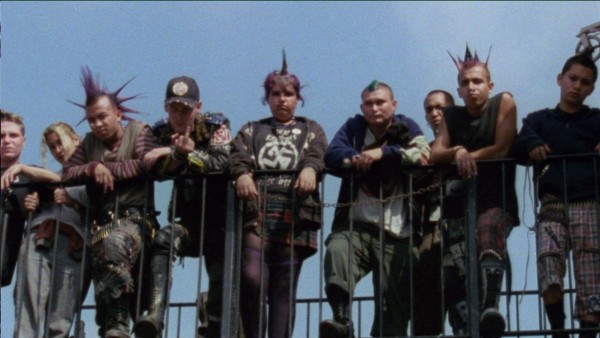Last week Glasstire was in Mexico City, interviewing four prominent artists from the region for a series we’ll run in the fall. One of the artists, Sarah Minter, has a retrospective on now at MUAC, the major contemporary art museum at the big university in the southern part of the city. Minter is a video artist, and really made her name in 1987 with a piece of narrative cinéma vérité called Nadie es Inocente (No One is Innocent), which is about a punk scene that grew out of a poverty stricken area just outside of Mexico City.
The punks in that movie aren’t musicians. They’re aimless, frustrated teenagers who’ve embraced the style and sound of ‘70s punk rock—like countless other young people all over the world around that time—as a force that embraced and validated their aggression and their despair that their time and place didn’t hold much for them. It didn’t matter to them that Sid Vicious was long dead. His dazed, violent life and death made perfect sense to them as they drifted and gathered and snorted glue and pogoed around squats and dumps in Neza City, which is part of the world’s largest slum. One of the kids hops a train in attempt to change his scenery, but he ends up lonely and tries to find more punks to hang out with even in desolate, rural places.
While watching the movie, I kept thinking about Penelope Spheeris’ series of anthropological documentaries about the LA rock scene—The Decline of Western Civilization, Parts I-III—which were finally re-released last month after being frustratingly very unavailable for years in any web format. For those of us who grew up watching the Decline series, Spheeris’ name is as synonymous with ’80s and ‘90s punk and metal culture as Michael Apted’s is with the hard truths of growing up and aging. I can’t count how many times I tried to find particular clips from Parts I and II to illustrate certain points I was trying to make in writing or curating, and it turns out Spheeris herself was responsible for keeping the Declines off any video hosting site.
I rewatched all the Declines yesterday, and for some reason, probably the time frame, I thought the first Decline (1981)—about the seminal LA punk bands—would be most simpatico with Minter’s vision of Mexican punks. But it’s the third Decline—which is often overlooked in light of the more straightforward Decline I (very punk) or flashier Decline II (metal, and often very funny)—that has the most in common with Minter’s punks. It was released much later, in 1998, and I only remembered that I’d watched it before when I started groaning at a scene near the start of the film when the liberty-spiked kids lining up outside a punk venue all cop to being not born yet when the first Decline was released. They worship that earlier movie and the bands in it (X, The Germs, Black Flag, et. al.) but they can’t seem to create a music culture that’s their own.
As the movie unfolds, you start to understand why. These pierced and be-spiked teens are homeless. They’re the gutter punks of Hollywood, beaten or molested or tossed out by their parents. They’ve created an ad hoc family with one another as they panhandle and drink all day and crash punk venues at night to mosh away their boredom and resentment. Spheeris interviews one after another, and I realized I hadn’t finished the movie the first time I watched it, which was probably shortly after its original release (certainly on a VHS tape and probably bootlegged). When I was 28, I didn’t have patience for these kids and likely wouldn’t have reached the halfway point in the movie, when Spheeris stops pretending it’s about the shitty bands (who haven’t moved punk forward by a millimeter by then and had, in fact, turned it into the narrow, calcified, pedantic thing it became) and realized her subject was actually the street kids, who are fascinating and heartbreaking. They’re drunks, yes, but they are political (that’s where the music comes in for them) and they can talk about the economy, the disappearing middle class, and political corruption with the finesse of their older punk heroes. (Keith Morris of Black Flag and the Circle Jerks makes a sage appearance, as does Rick Wilder of the Mau-Maus.) They have first-hand experience with how callous the world is and what economic disparity looks and feels like in a first-world city. They’re white, black, Hispanic, Filipino. They duck the skinheads. They’re sullen at times, but also idealistic, and very young. Most of them have been on the streets for years.
More so, you can see that these kids are the crusty forebears of the original Occupy movement. There were a lot of these kinds of kids among the thousands who filled Zucotti Park and downtown Manhattan in 2011 to alert a complacent nation that the status quo was not only broken, but a shame and a disaster for the future of nearly everyone in it. In Spheeris’ film, which did well at Sundance but couldn’t get distribution due to lack of larger interest, you can see that the kids are our doomed canaries as you realize that things are not only no better now, but actually worse. These kids were using, via a punk-rock ethos, the political language that wouldn’t hit the mainstream for another generation.
Punk may be dead now, but it was right.
The Decline of Western Civilization series is available to stream on Amazon and iTunes. Watch them in order. OR BETTER YET see them on a big screen in Austin with filmmaker Penelope Spheeris in person, Aug. 28-29, presented by Austin Film Society.







5 comments
Amazing review, Christina. Renting them all tonight.
“Punk died when the first kid said,
‘Punk’s not dead. Punk’s not dead.'”
WAIT! Before you rent these, waay way better to see them presented big in Austin with filmmaker Penelope Spheeris in person Aug. 28-29. Important. https://www.austinfilm.org/retrospectives-and-themed-series/series-penelope-spheeris-live-in-person
Woah! I’ll add this under the other info. Thank you, Peter.
For a pleasant new perspective, check out the 1982 dystopian Burst City, and remember as your watching the Japanese punks, they are all dressed and (punk) behaving in a pre-image-sharing world where they actually had to travel or interpreted from magazines and the videos that made it to Japan to even begin to live as punks. Good watch.